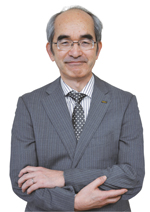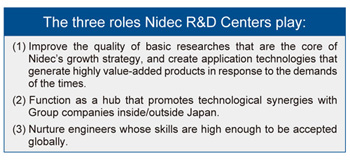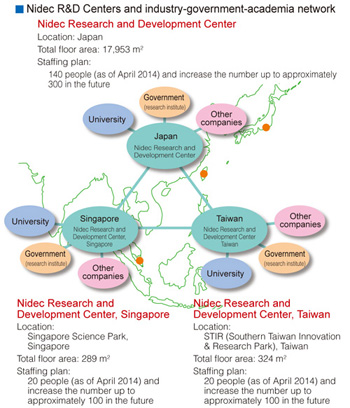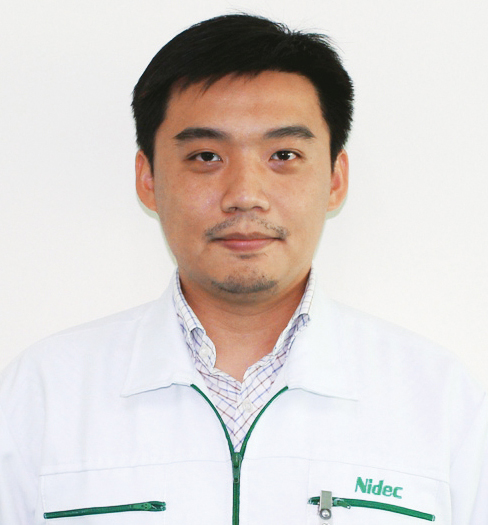Special Feature 2013 - Looking Ahead 100 Years to Evolve as a Truly Indispensable Business
2. Basic Research for a Better Future
Three R&D Centers Open in Asia

Imagine how people will define “desired products” 100 years from now. Our newly-established research and development centers in Japan, Singapore, and Taiwan are now gearing up to discover the answer. Mr. Yasushi Fukunaga, supervising the three R&D centers, talks about the background, purposes, and workings of the new facilities.
To be a “No. 1 company
for both its Products and R&D”
Research Laboratories Navigating Through the Era of Unprecedented Changes

Q. How do you describe the research activities undertaken by Nidec Research & Development Center?
Fukunaga: Nidec has specialized in “products that spin and move,” and has been seeking to acquire all technologies related to small precision motors. For 40 years, we have determined our target markets, such as PC, office equipment, and automotive, and been dedicated to providing products based on the technological level that satisfies individual customers’ needs. This policy, which prioritizes developing technologies that satisfy customers’ individual needs, will remain unchanged: Each technical center will be there to fulfill the responsibility. On the other hand, the new R&D Centers’ basic researches will go beyond existing products, markets, and businesses. They will include application researches for product commercialization, anticipate technologies that will be universally required in all products’ and manufacturing processes, as well as products that will be essential in the future society, and move forward by accumulating technologies that will undoubtedly be needed by the society. In other worlds, the R&D Centers were established to build “a techno-stock (technological assets) for the future.”
Q. What motivated Nidec to step up basic research, and why now?
Fukunaga: Let’s think about the future by looking back on the past. In the industrial society, which is believed to have started with the invention of the steam engine in 1776, there were several infrastructural technologies. It was when these core technologies made a significant advance that the society underwent a large-scale change. In terms of engine mechanism, the invention of the steam engine allowed for distribution of power by use of the electric motor around 1890. After 1950, we learned to use computation to control power output. Since around 2010, the industry’s primary focus has been shifted to the decentralization of power sources.*1 These changes occurred approximately on a 60-year cycle. On the IT front, the industry has undergone waves of paradigm shifts every 15 years since traditional mainframe computers gave way to personal computers in and around 1980, followed by the advent of the Internet in 1995, and then by the full-fledged proliferation of cloud computing around 2010. Based on historical analogy and from the perspective of sociology for information, I believe that, in or after 2010, we entered an age of major change which began to shape a new social landscape. One possible scenario for that is a spread of mobility society, enabled by the decentralization of power sources.*2 Looking back on the major changes of the social infrastructure, many of those who entered the business first became a leader, and many of such leaders successfully achieved positive results. In the 19th century, it was the United Kingdom, where the steam turbine was born, that led the world, whereas, it was the Unites States’ West Coast that changed the world when the personal computer was born 30+ years ago. To quickly react to yet-to-be-seen, new social needs, it is necessary to start now and establish a research and development system that connects research institutes that conduct thorough basic researches with existing technological centers.
※1 Decentralization of power sources Small-scale power generation facility either in or nearby point of demand, which is different from a large-scale, centralized power generation by an electric power company.. ※2 Mobility society enabled by the decentralization of power sources Current mobile electrical products, which are, in principle, recharged before their use, can only be moved within the distance with its recharger or power source. However, if the product itself is equipped with a power generating capability, it can be moved regardless of such a distance. A mobility society is where electrical products that can be moved freely are used in many parts of the society.
Network-based, Convergence R&D

Q. What benefits do you expect from locating R&D facilities in Japan, Singapore, and Taiwan?
Fukunaga: As was the case in the economic field, Asia will very likely lead the world’s growth in the area of R&D. In the entire Asia, both Singapore and Taiwan are already well-known as technological centers, and home to world-class techno-parks. A good balance of diversity and convenience of these places enables many airplanes to travel between them, despite the geographical, cultural, and values differences.
Q. How will you make a difference under the new framework?
Fukunaga: This is a network and convergence R&D system. “convergence research” is one of the key terms currently used in the area of R&D in the world. The term “convergence” has many meanings, including “for organizations to work together in the true sense, and create synergies,” and “connect technologies to create new values.” The 20th century started as a period of invention and discovery, where things were created out of nothing; however, as technologies were segmentalized, impractical researches, which were for nothing, started to be performed in an increasing number. In light of these circumstances, the efficient way of performing R&D, in our opinion, is to select a theme of our research based on a wide range of view, identify, from numerous technologies existing in the world, those ones that are effective, and develop such technologies by integrating them with Nidec’s techno stocks superior to those of other companies, and use the effective technologies for our products. This is what we call “convergence research” as opposed to the 20th century’s “analysis-based” research, and we will continue to pursue the convergence research. The question is, “How will we select optimum research themes from numerous themes?” The answer to the question is a network of researchers. Researching and discussing with other researchers as a member of an open industrygovernment- academia research group where researchers from different fields gather provides us with various types of information. Our R&D Centers, located in three difference places, receive a diverse range of information. Based on the clusters of researchers from other companies, governmental organizations, and universities, sprouts of new ideas are born one after another from such information. The most unique characteristic of our R&D system is that it is “network-based.”
Future Only Shines Bright for the Companies Taking a Chance on the Unknown
Q. Lastly, what is the goal of Nidec as a company to be needed by the society for the next 100 years and beyond?
Fukunaga: As we all remember, three to four years ago we celebrated the 200th anniversary of the birth of Charles Darwin. As I have already stated, I believe that we are about to enter an age of chaos where a new social infrastructure is born. Those survived such an age of chaos were not dinosaurs, that were dependent on their strength and satisfied with what they were, but species that could adapt to environmental changes flexibly. Nidec employees are provided with a book called “the Challenging Road,” which is full of philosophies on which the company was founded, and we the employees are given opportunities to read the book repeatedly. These “philosophies” are what genes are for “species.” So long as we work based on these philosophies and maintain power to create valuable products, we will be able to be active as a new “species” that the society needs. Nidec will aim to be a company that is “No. 1 in R&D” and that can achieve the goals of enhancing its superior technologies to realize social needs into products faster than others, of creating a market of such products, and of continuing to be needed by the society.
VOICE

Center, Singapore
Research of products for a better future
I am in charge of technical research on motors for robot-related applications at Nidec Research and Development Center, Singapore. Small-size motors, Nidec’s main products, will likely become important parts of various robots in the future. I hope to further develop Nidec’s technology to make lighter, thinner and smaller products as well as its energy-saving technology, and engage in “researches on motors and control modules *3 that can be installed in micro-robots that can explore anywhere,” which is the ultimate form of products that can be achieved by those technologies. I engage in my research every day, dreaming of a future where robots are deeply integrated in people’s everyday life to make it affluent, while wishing that our researches will contribute to the development of the society.
※3 Module A component that consists of a group of several partial functions.

